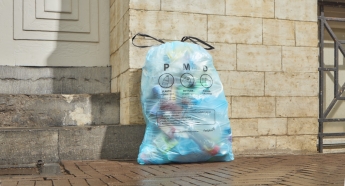Fruit purees have become increasingly popular in recent years, packaged in convenient, often shiny squeeze bags or pouches. Until recently, an aluminium laminate was generally used in these that was either impossible or difficult to recycle. That has now changed, as more and more manufacturers switch to recyclable mono-materials.
Fruit purees in pouches are popular with young and old alike because of their convenience, for example as a snack on the go or at school. You don’t have to peel the fruit yourself in advance and the purees come in an airtight bag, which means that they keep for a long time. As well as being handy, the pouch packs with their shiny surface and attractive colours stand out on the shelves.
Pouches – complex and anomalous packaging
Pouches also have many advantages in terms of logistics. For instance, they are a lot lighter than the glass jars in which apple puree is packaged, which reduces the carbon emissions from transport. What’s more, because they are easy to stack, the pouches take up less space in the truck.
Unfortunately, until recently such pouches were also a fairly complex type of packaging that in practice was not recyclable. ‘The pouches mostly used an aluminium laminate,’ explains Annemarie Abbeel, Sustainable Packaging Manager at Fost Plus. ‘A layer of aluminium a few microns thick – serving as a barrier against light and oxygen – is laminated between two layers of plastic. The outer layer of PET accounts for the shiny exterior and is resistant to the heat of the sealing process during production. On the inner side, a layer of polypropylene (PP) provides a gas-tight seal that ensures food safety and shelf life.’
The transition to the new generation of pouches is in full swing. Many producers have already changed their entire range to mono-material. We’re calling on all companies that still use aluminium laminates to make the transition as soon as possible.
From multi-layer to mono-material
Three different materials, then, and ones that cannot be separated from each other either. That is disastrous for recycling. ‘Fortunately, we’re seeing more and more manufacturers switching to the new generation of pouches that use just one type of plastic: polypropylene. The aluminium layer is replaced by a barrier of vapour-deposited aluminium oxide (alox) or silicon oxide (siox) that offers the same guarantees in terms of food safety and shelf life. As long as the barrier material does not exceed 5% of the total packaging, it can be recycled together with the plastic without any problem.’
Polypropylene film from the blue bag is recycled together with other plastic films at Ecoo in Limburg, which uses the material to make products such as flower boxes and traffic markers. ‘But we’re also looking into the possibilities for chemical recycling. This could take place, for example, at the new Indaver facility in the port of Antwerp. The recyclate would then immediately be suitable for new food packaging. The polypropylene packaging is in any case future-proof, including in the context of the upcoming new European PPWR legislation.’

A place in the blue bag
The transition to the new packaging materials is in full swing. Major producers such as Materne have already changed their entire range to mono-material, as have the own-brand labels of Delhaize, Carrefour and Colruyt. ‘Several other producers have already told us that they will switch by the end of 2025. We’re also calling on all other companies that still use aluminium laminates to make the transition as soon as possible. They also benefit financially from this. Due to eco-modulation, the Green Dot rate for non-recyclable materials is at least double the highest recyclable rate.’
The transformation will also be reflected in the sorting rules for Belgian consumers from 2025. Pouches and other types of multi-layer packaging will then be removed from the list of packaging that is not allowed in the blue bag. ‘We’ve passed the tipping point: the majority of pouches that come onto the market consist of recyclable mono-materials. It would therefore be a shame to let these materials end up in residual waste,’ concludes Annemarie Abbeel.
- Check our Design-for-Recycling Guidelines.
